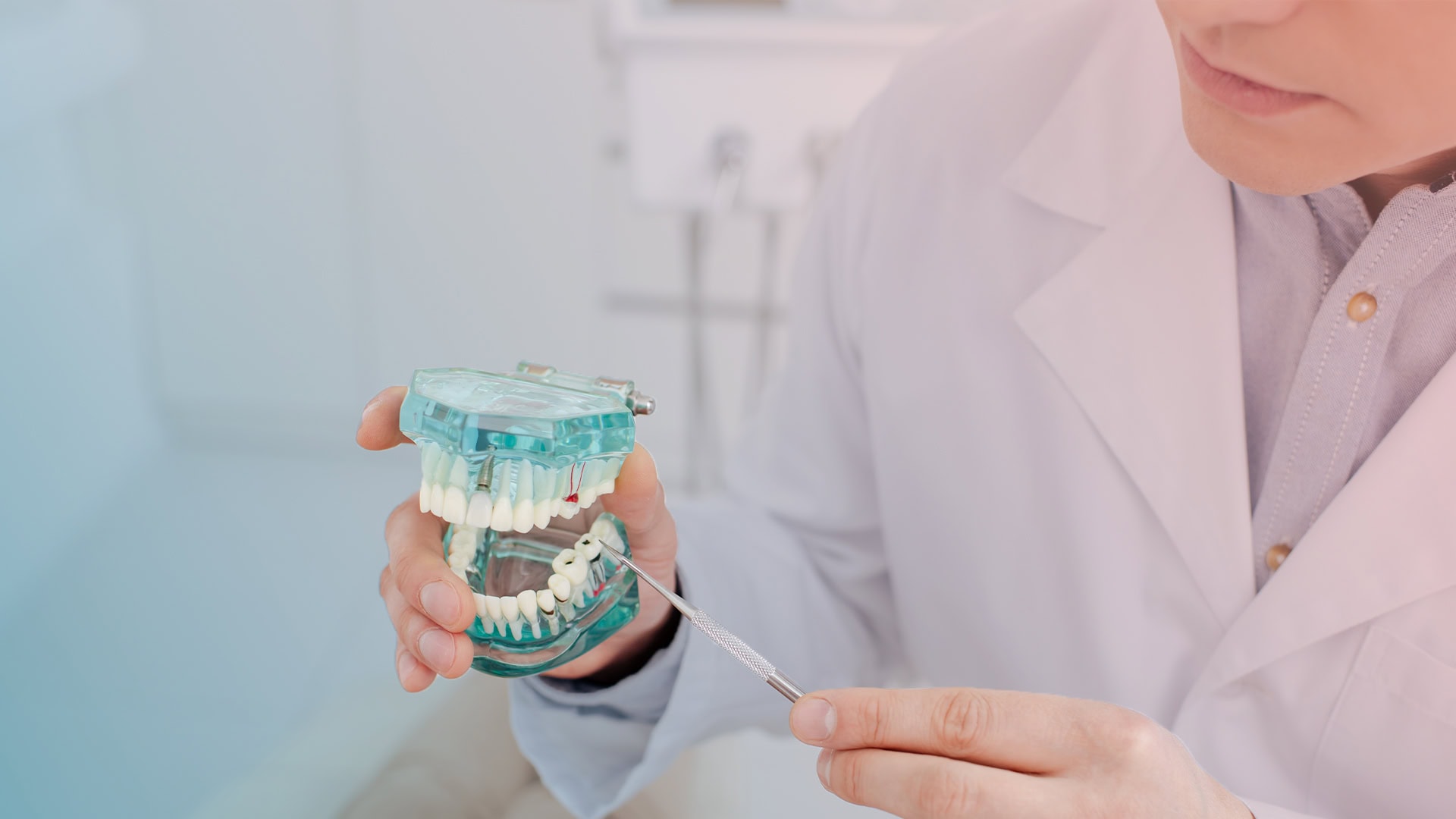Menu
Free Consultation

Peri-implantitis is the progressive infection that affects the soft and hard tissues surrounding a dental implant. Often, this infection involves the chronic inflammation of multiple tissues that can ultimately result in bone loss or implant failure if left untreated.
The most crucial aspect of peri-implantitis is that it’s not a sudden condition. Before impacting the alveolar bone around the implant and causing all its consequences, the disease must go through an initial phase called mucositis.
Unlike peri-implantitis, which is an irreversible affection of all the structures around the implant, mucositis is a reversible condition influencing only gum tissues, making this initial stage significantly more manageable and easier to treat. As a result, early detection is crucial to allow a quick recovery and prevent further complications.
The most important and frequent cause for peri-implantitis is dental plaque and tartar build-up induced by inadequate oral hygiene. Therefore, most cases are preventable with the appropriate hygiene routine and healthy habits.
Other causes can include:
● Systemic diseases like diabetes.
● Harmful habits, such as smoking or severe grinding.
● Strong medications and therapies, such as chemotherapy and radiotherapy.
● Some medications that could interfere with the osseointegration.
● Biomechanical overload due to inadequate planning or prosthetic rehabilitation.
The most common symptoms of peri-implantitis include:
● Bleeding and swollen gums: They’re the first symptoms to appear, caused by the inflammation of the soft tissues surrounding the implant. This sign can appear when brushing or spontaneously, and it’s the first sign of alarm to schedule a check-up appointment.
● Bad breath: Once bacteria get trapped between your tissues and the implant, they can produce a bad smell and even a bad, metallic taste.
● Pus: When the infection spreads to other hard tissues, your body tries to trap as much of it as possible, creating purulent exudate.
● Implant mobility: It is a more severe sign that implicates the affection of the bone surrounding the implant.
If you notice any of these symptoms in your mouth, but more importantly, associated with your new implant, seek professional care as soon as possible. Don’t wait for the symptoms to worsen, as it can affect the peri-implantitis treatment and lead to multiple complications.
Prevention: How to Protect Your Dental Implants
Your implant treatment doesn’t end with your final prosthesis; it continues with you at home by taking the appropriate measures to take care of it and extend its lifetime to the maximum and in the best shape possible. Here are some practical pieces of advice you can take to maximize the life of your implants and prevent peri-implantitis.
Daily oral hygiene is the most crucial aspect to look for as a bearer of dental implants. It’s essential that you brush your teeth at least twice daily, but preferably after each meal, using fluoride toothpaste and dental floss. Keep in mind that oral hygiene is even more important for implant patients than for natural teeth.
Also, incorporating antimicrobial rinses, such as alcohol-free chlorhexidine mouthwashes, can decrease bacterial count and prevent multiple issues—including peri-implantitis.
The tools you use for home hygiene are almost as critical as the technique itself. Experts recommend using a specialized soft-bristled, implant toothbrush and avoiding medium or hard bristles entirely. Additionally, the use of water flossers has been highly indicated for implant patients as it makes the cleaning in difficult areas easier while preventing damage to the implant.
Avoid abrasive or hard materials, such as metallic interdental brushes, when you clean the area around your implant, as it can damage the implant surface and promote plaque build-up and even more inflammation.
Due to the considerable link between nutrition and oral health, experts recommend avoiding sugary meals, acidic foods, and excessively hard foods—including bones, hard nuts, and similar. On the other hand, foods rich in vitamins C and D, calcium, and proteins are highly valuable to keep the bone and soft tissues healthy.
Peri-implantitis treatment depends on the severity and stage of the disease. As a result, intervening at early stages makes the management of the disease relatively easy and less complex. However, its treatment can range from a simple cleaning to removing the implant.
Non-Surgical Therapies
The first line of defense is removing the local irritants—dental plaque and tartar—with a professional dental cleaning, using specialized cleaning bits to avoid damage to the implant’s surface. Your dentist will also indicate antiseptic rinses and other hygienic measures.
Other modern treatment alternatives to deal with peri-implantitis include the use of laser-assisted therapy, which uses a powerful beam of light to clean the surface and remove bacteria and plaque.
Surgical Solutions
Advanced stages, on the contrary, will require surgical alternatives, such as:
● Regenerative surgery, to produce new bone.
● Flap surgery, to correct gum recensions around the implant and protect its surface.
● Bone grafting, placing new bone to restore bone loss.
However, the exact treatment will depend on your evaluation and the stage of the disease. Some patients will require the combination of two or more of these alternatives to obtain the desired results. In severe cases, the surgeon might opt to replace the implant entirely, place new bone, and then place a new one after the recovery.
Peri-implantitis treatment depends on the severity and stage of the disease. As a result, intervening at early stages makes the management of the disease relatively easy and less complex. However, its treatment can range from a simple cleaning to removing the implant.
The first line of defense is removing the local irritants—dental plaque and tartar—with a professional dental cleaning, using specialized cleaning bits to avoid damage to the implant’s surface. Your dentist will also indicate antiseptic rinses and other hygienic measures.
Other modern treatment alternatives to deal with peri-implantitis include the use of laser-assisted therapy, which uses a powerful beam of light to clean the surface and remove bacteria and plaque.
Advanced stages, on the contrary, will require surgical alternatives, such as:
● Regenerative surgery, to produce new bone.
● Flap surgery, to correct gum recensions around the implant and protect its surface.
● Bone grafting, placing new bone to restore bone loss.
However, the exact treatment will depend on your evaluation and the stage of the disease. Some patients will require the combination of two or more of these alternatives to obtain the desired results. In severe cases, the surgeon might opt to replace the implant entirely, place new bone, and then place a new one after the recovery.
As you may have noticed, catching peri-implantitis early is crucial for its resolution. Therefore, attend to professional cleanings every 3–6 months and keep a consistent monitoring to catch problems early.
Smoking and having an inadequate diet are dental implants’ worst enemies. Try to avoid them as much as possible, as tobacco smoke debilitates the gums and makes you more prone to these infections. If you have any chronic systemic conditions, like diabetes or periodontal disease, you should address them promptly to prevent more complications.
Istanbul provides high-quality care, experienced dental surgeons, and affordability of your dental treatment while adhering to the highest quality practice standards. As a result, the city is a top destination for global dental tourism.
Besides the great preparation and knowledge of the professionals, multiple Istanbul clinics offer advanced imaging, laser technologies, and 3D surgery alternatives that make the treatment easier and faster, with personalized implant restoration options, including all-on-4 and all-on-6 implants.
Peri-implantitis affects an estimated 10% to 20% of dental implant patients, depending on factors like oral hygiene, health status, and implant maintenance. While it’s not inevitable, it's more common in patients who smoke, have poor oral hygiene, or suffer from chronic conditions like diabetes.
You can reverse peri-implant mucositis, the early stage of infection that doesn’t involve bone loss. However, peri-implantitis itself cannot be fully reversed once bone damage occurs. It can be controlled and treated effectively to prevent further progression with professional care.
Most treatments are performed under local anesthesia, so pain during the procedure is minimal. After treatment, you might feel mild discomfort, swelling, or sensitivity, which typically resolves in a few days. Advanced techniques, including laser therapies, reduce the need for invasive surgery and shorten recovery time.
Recovery varies based on the severity of the infection and the type of treatment. Non-surgical procedures may need only a couple of days for recovery. Surgical treatments, like bone grafting or flap surgery, can require 1–2 weeks for initial healing and several months for full integration.
Yes. Dental implants remain one of the safest and most effective long-term solutions for tooth replacement. With proper planning, hygiene, and regular check-ups, the risk of peri-implantitis is low. Choosing experienced implant professionals further reduces complications.
Fortunately, peri-implantitis is preventable and treatable with the appropriate and timely measures. With the right care, modern solutions, and regular dental check-ups, you can protect your dental investment and health long-term.
Author: DDS, PhD Ömer Faruk Şarkbay (Implantology Specialist)
